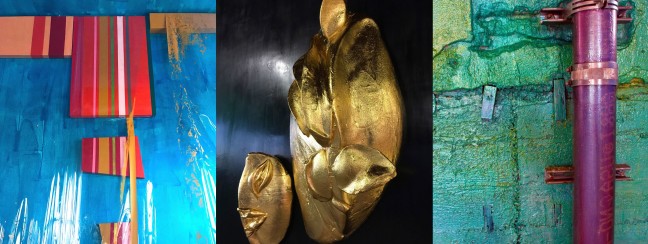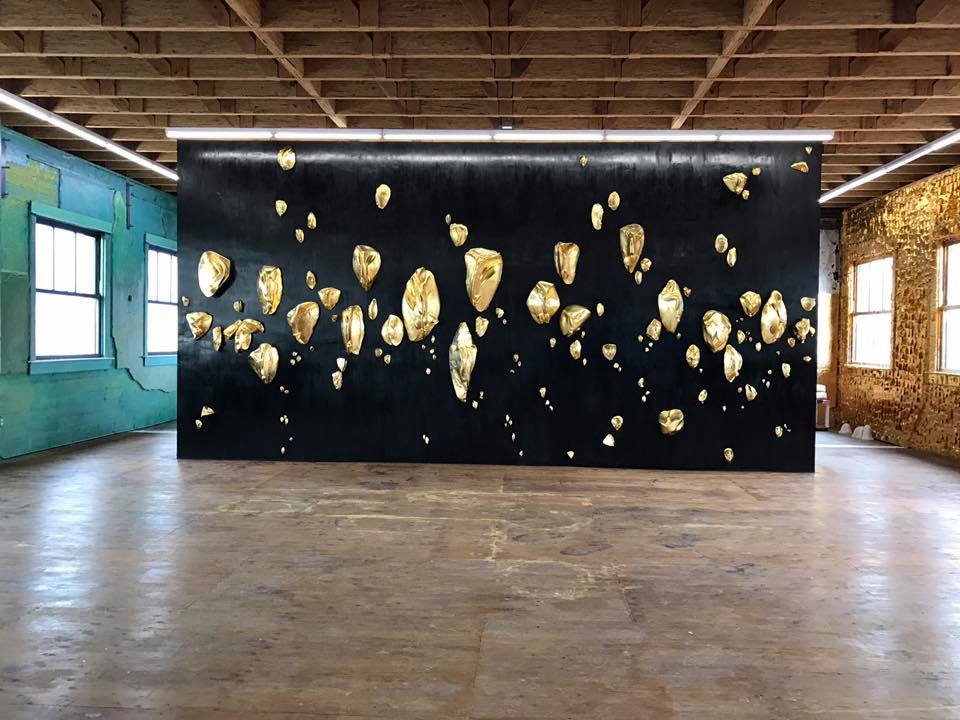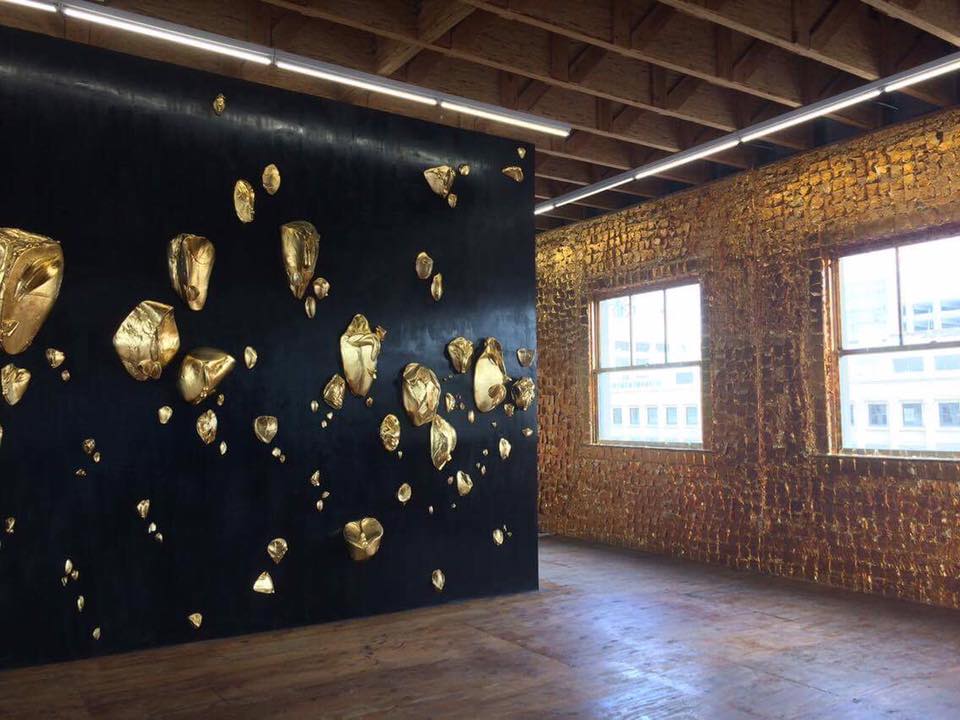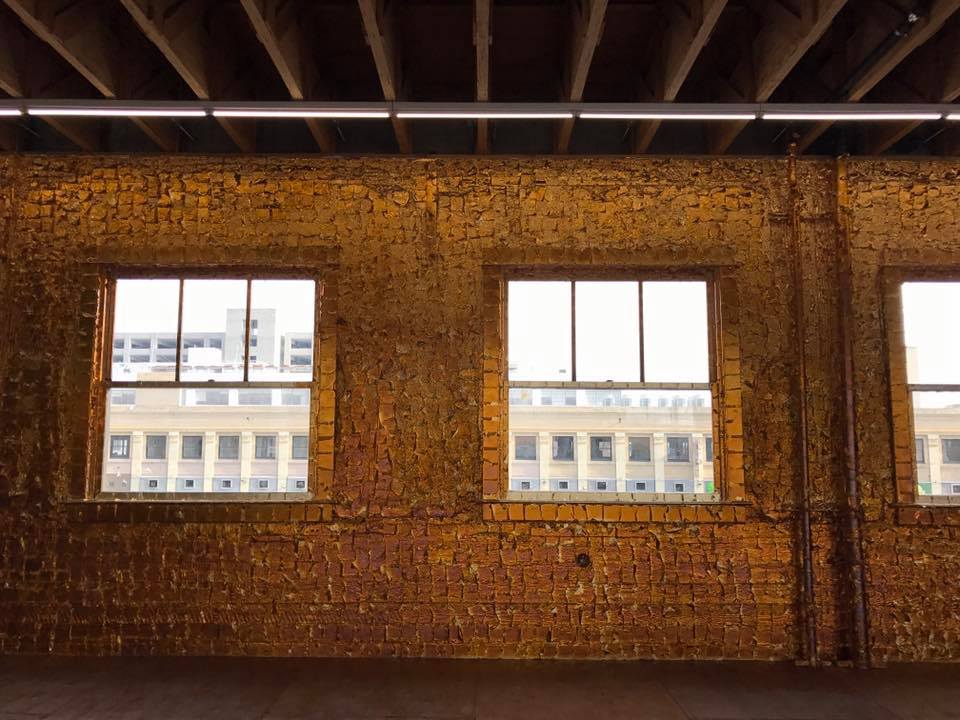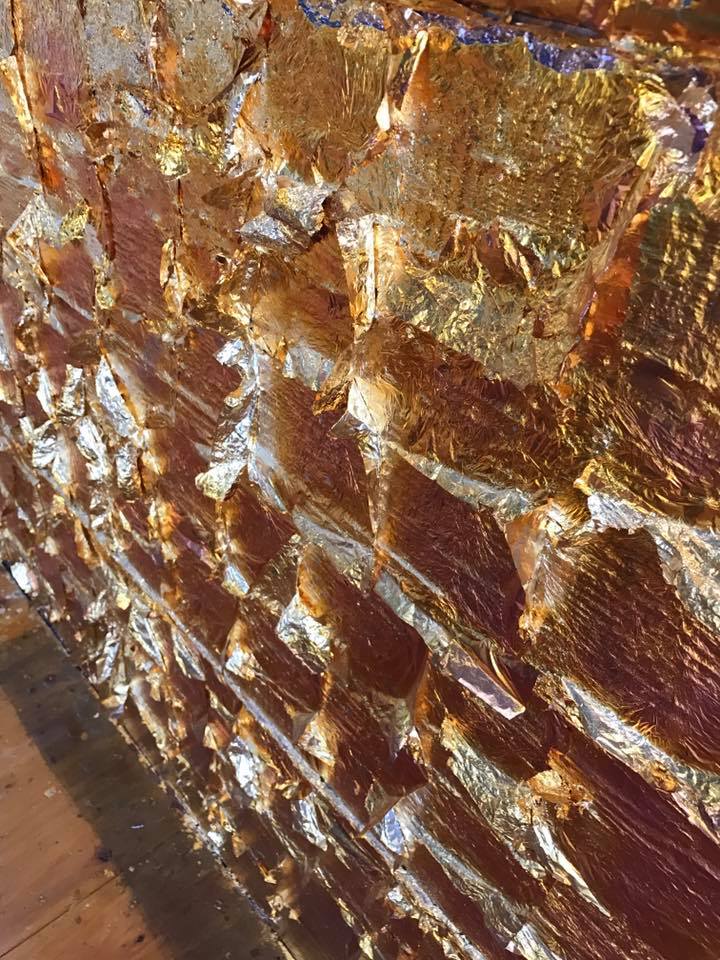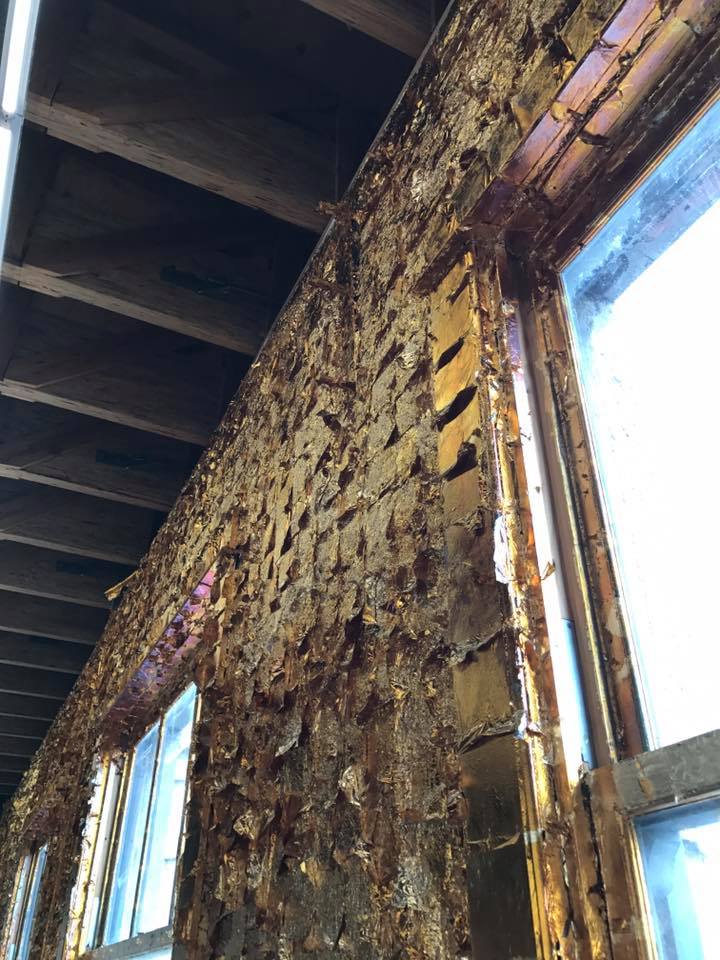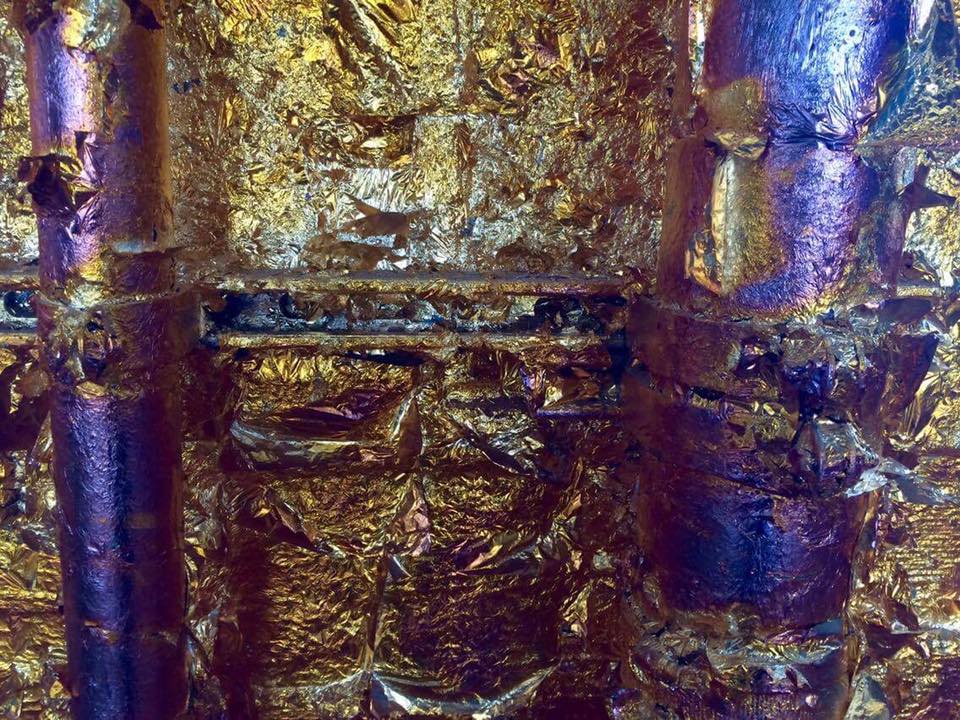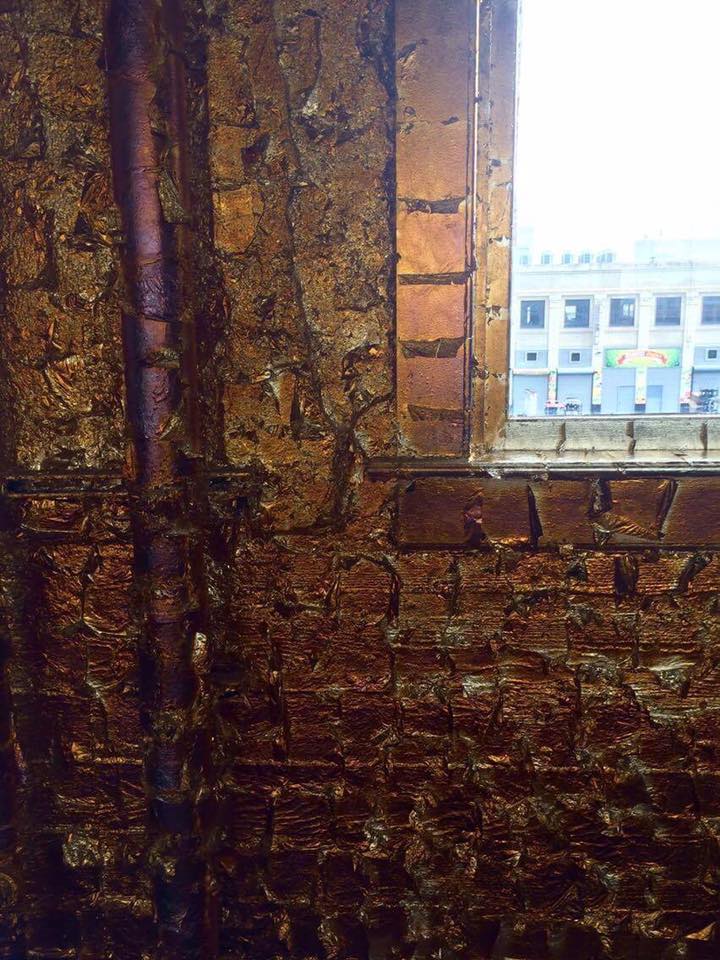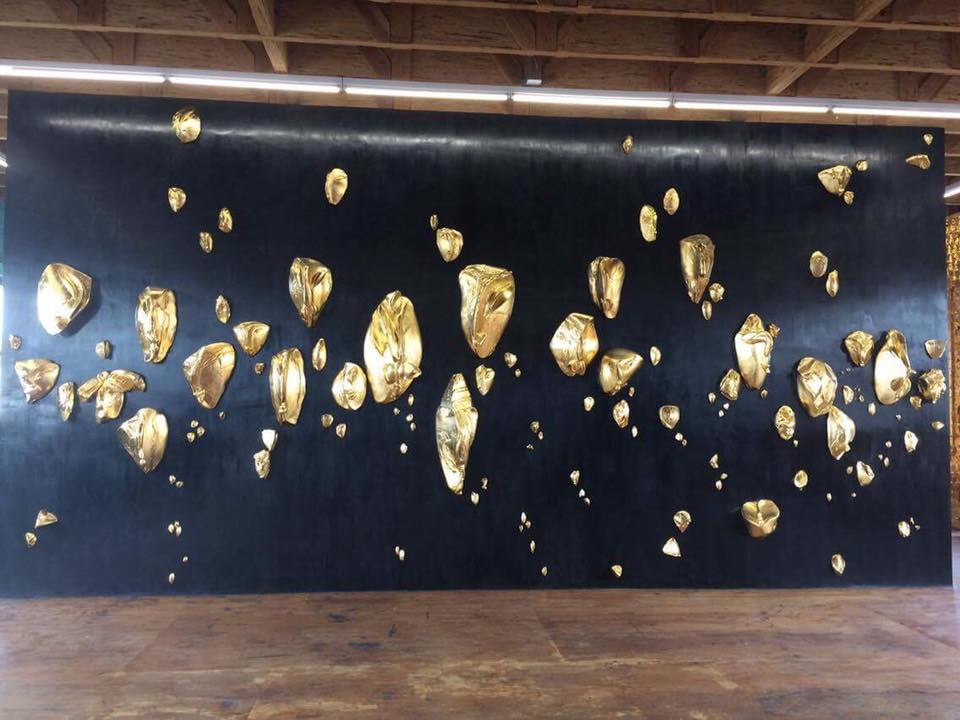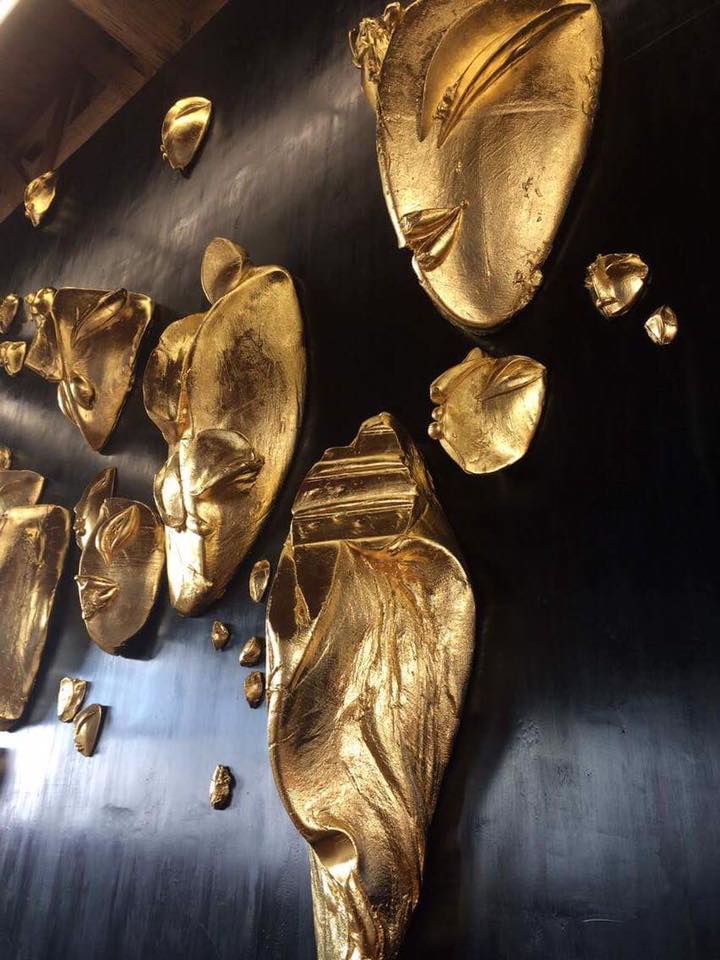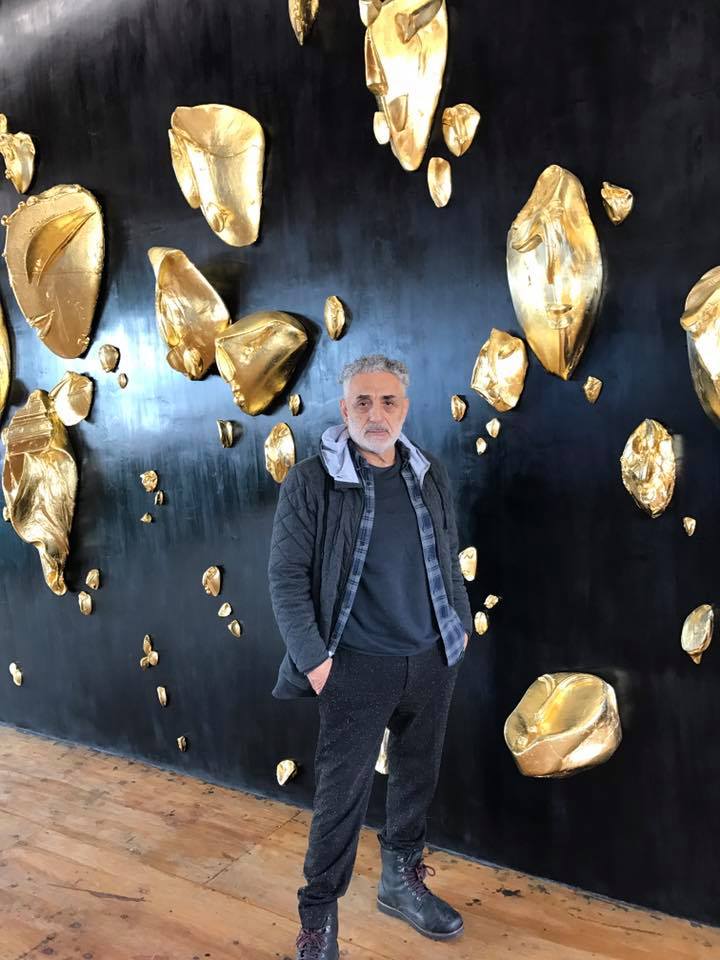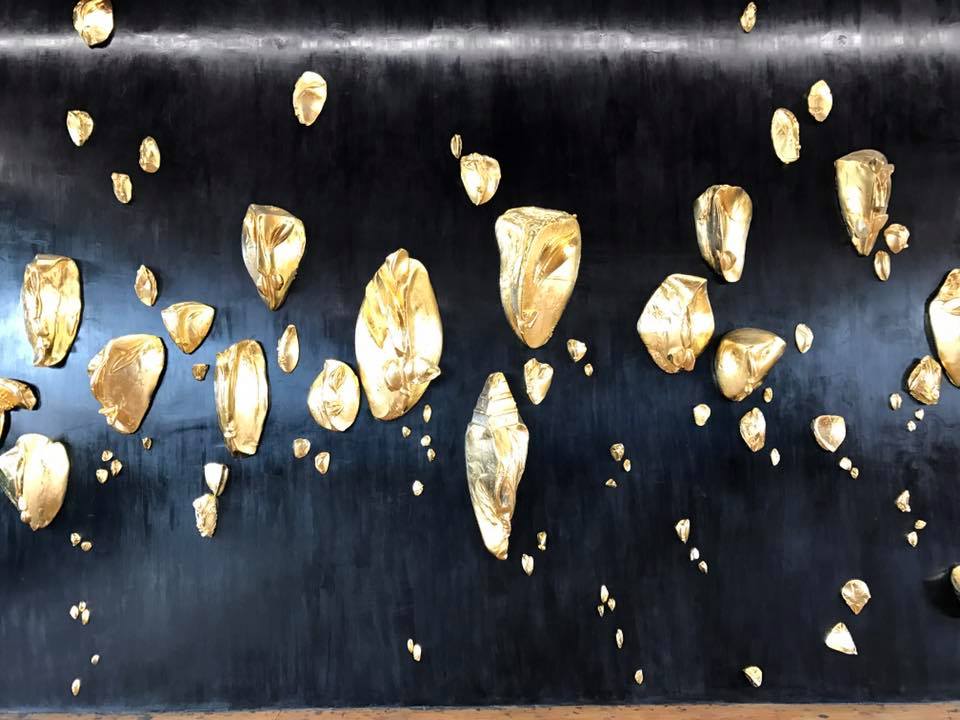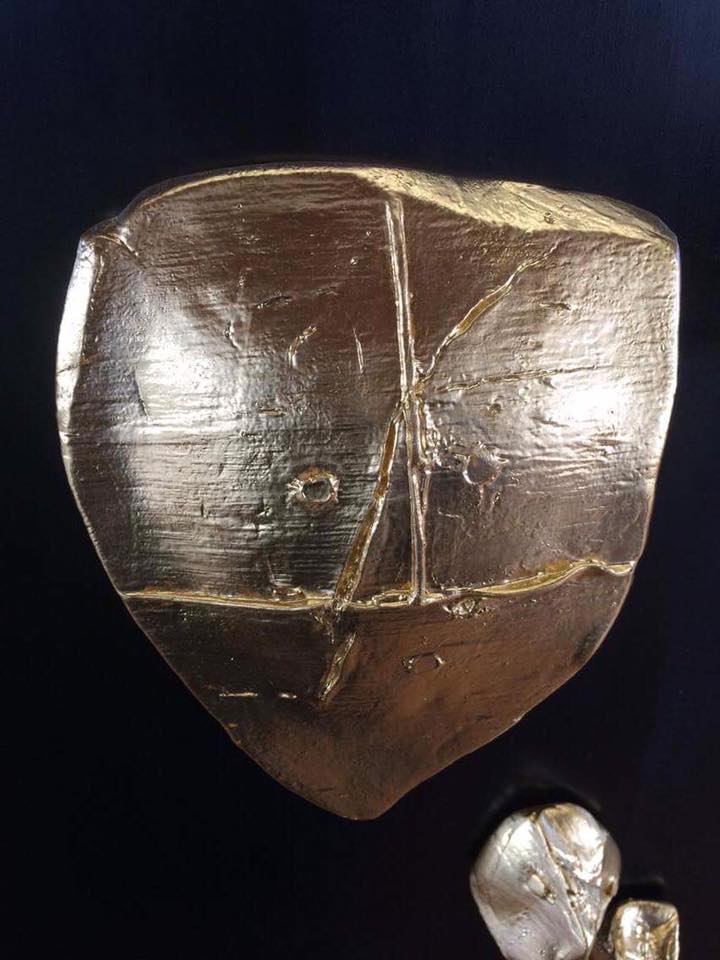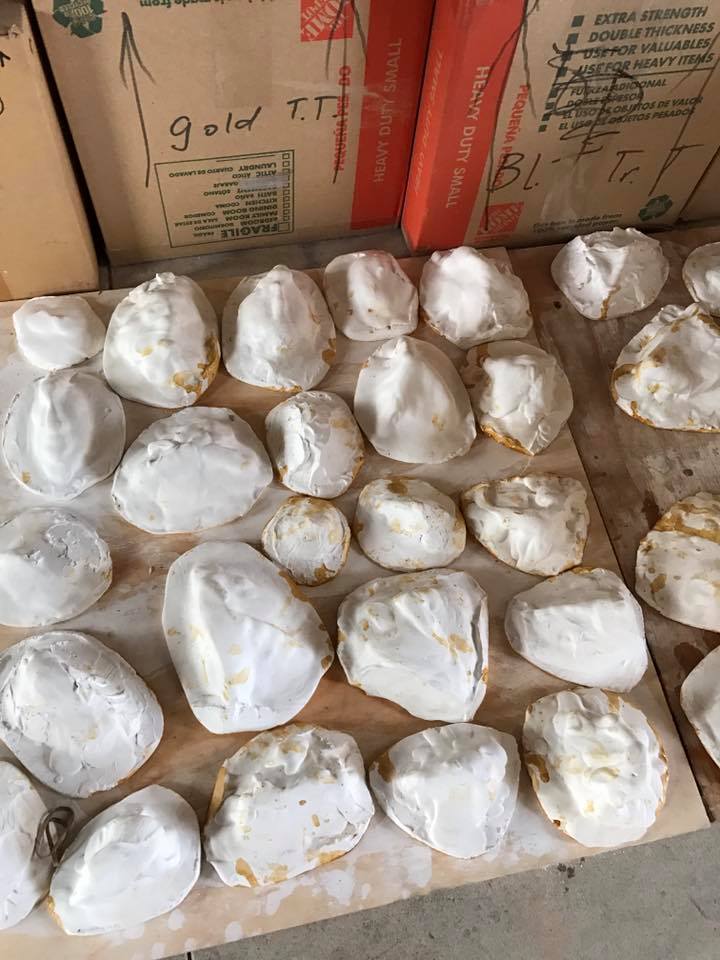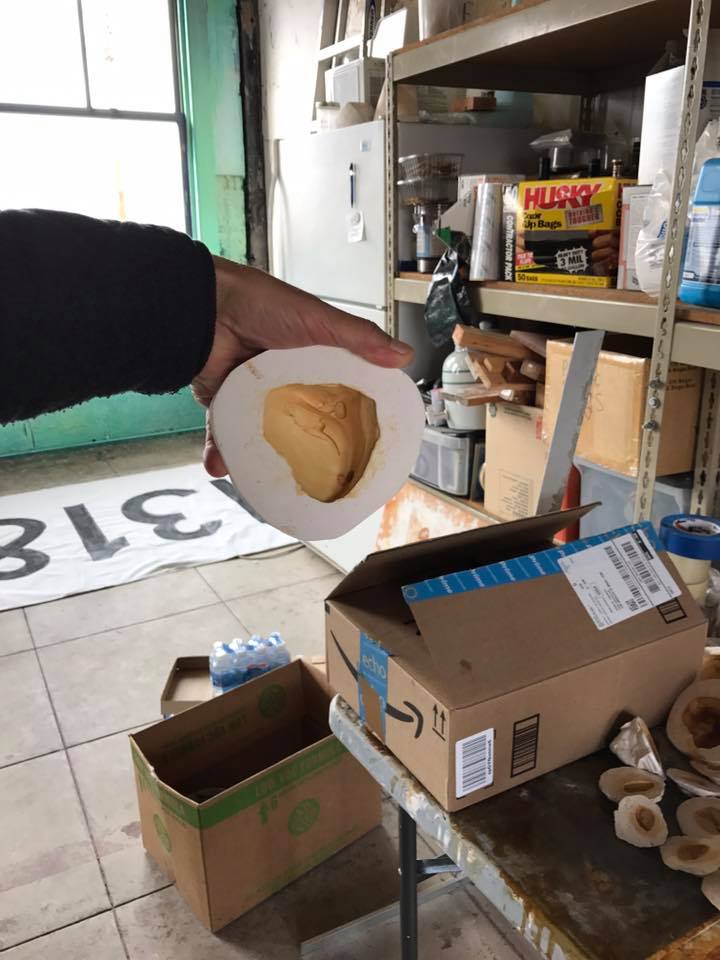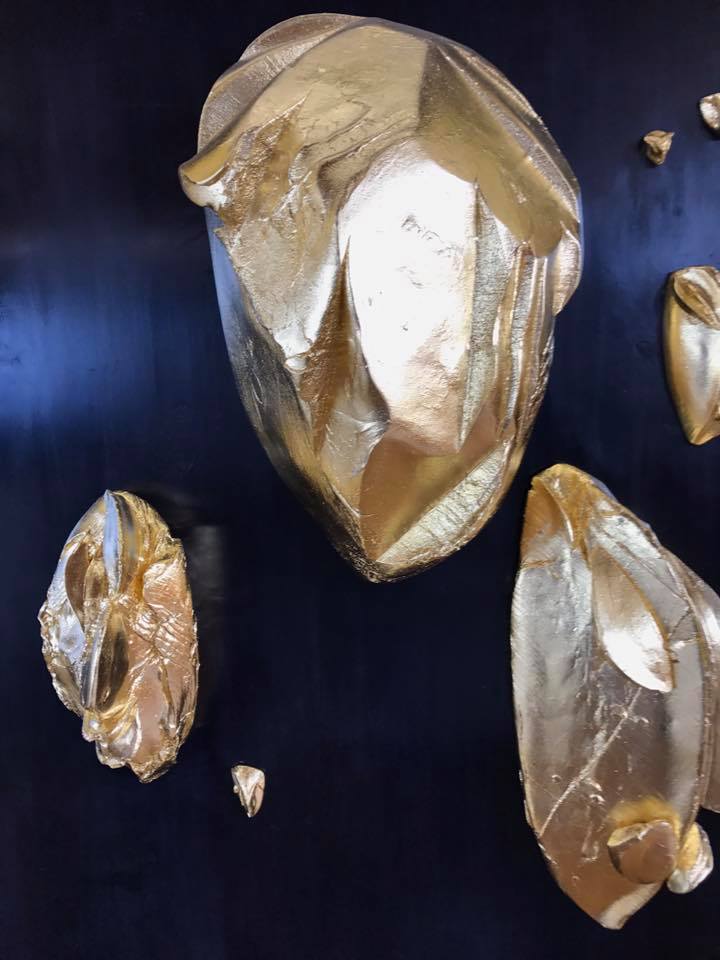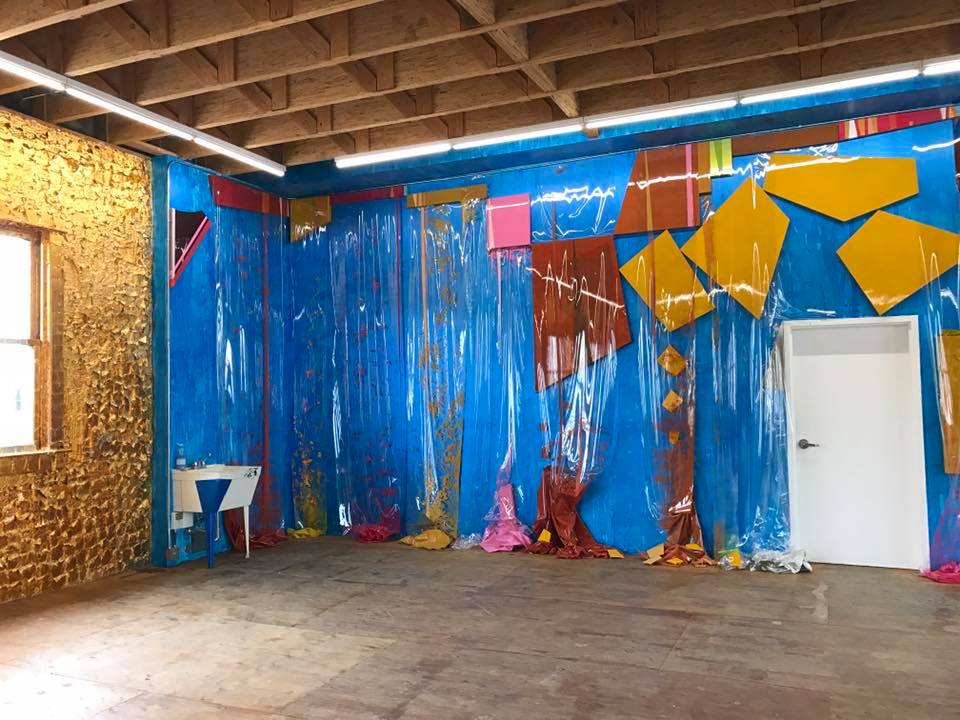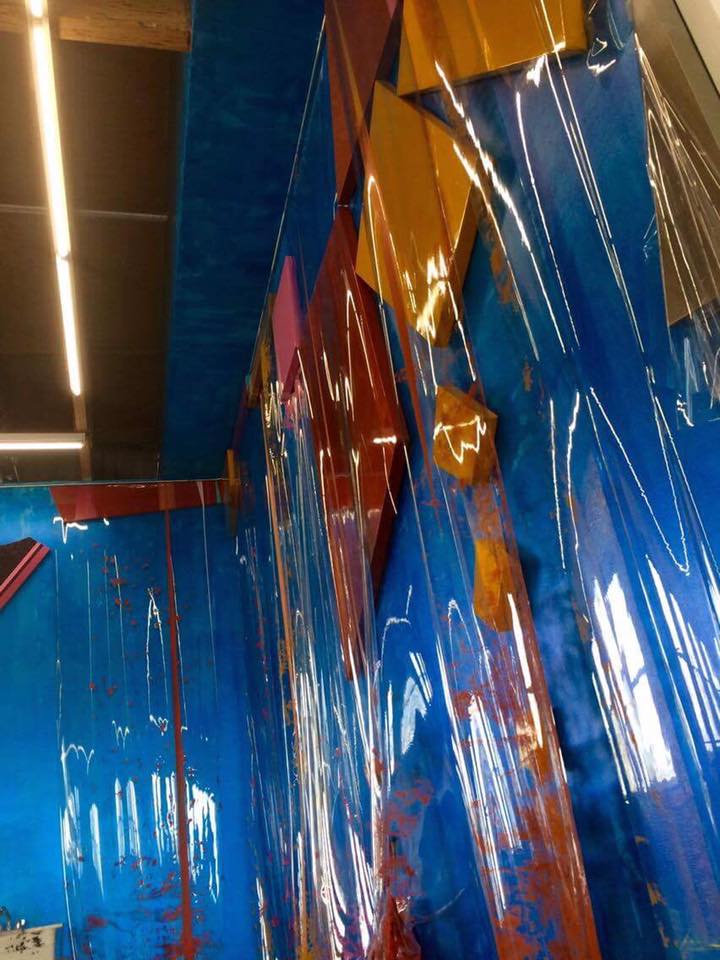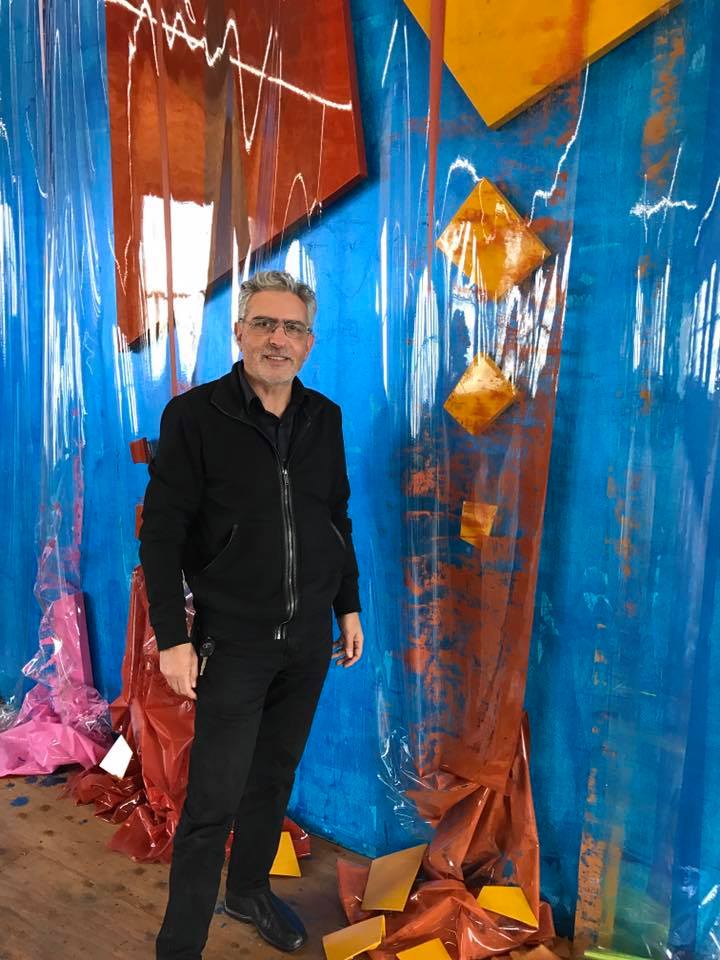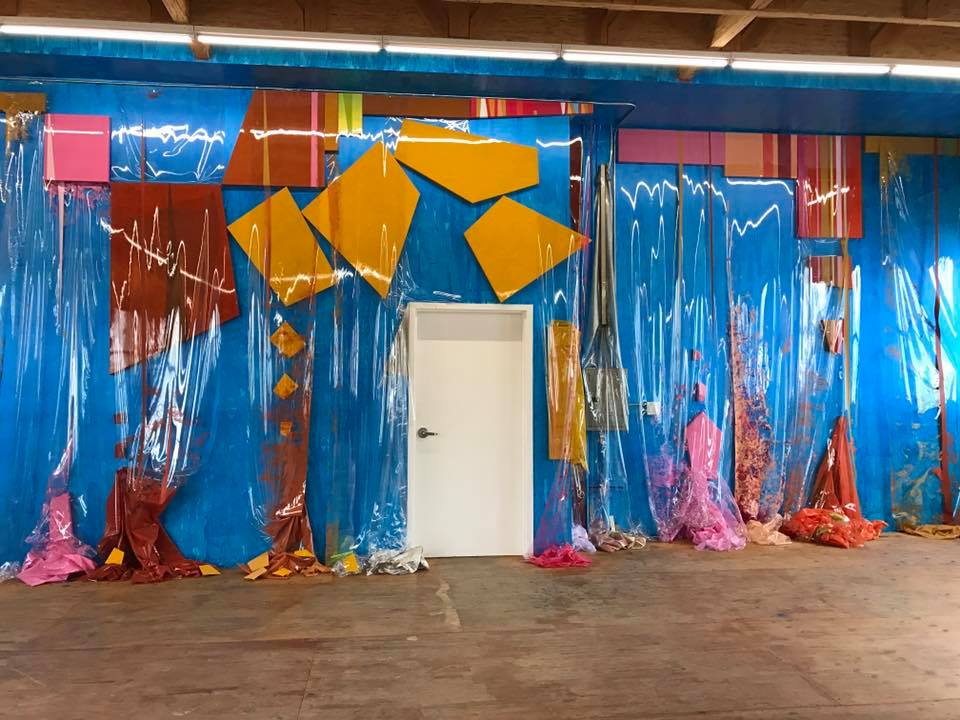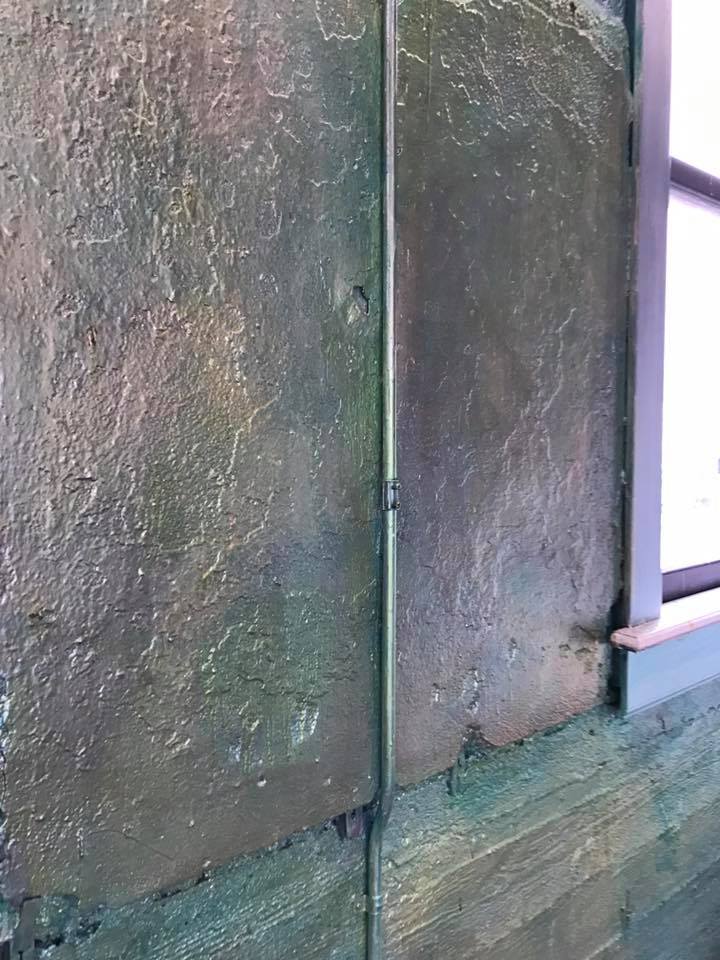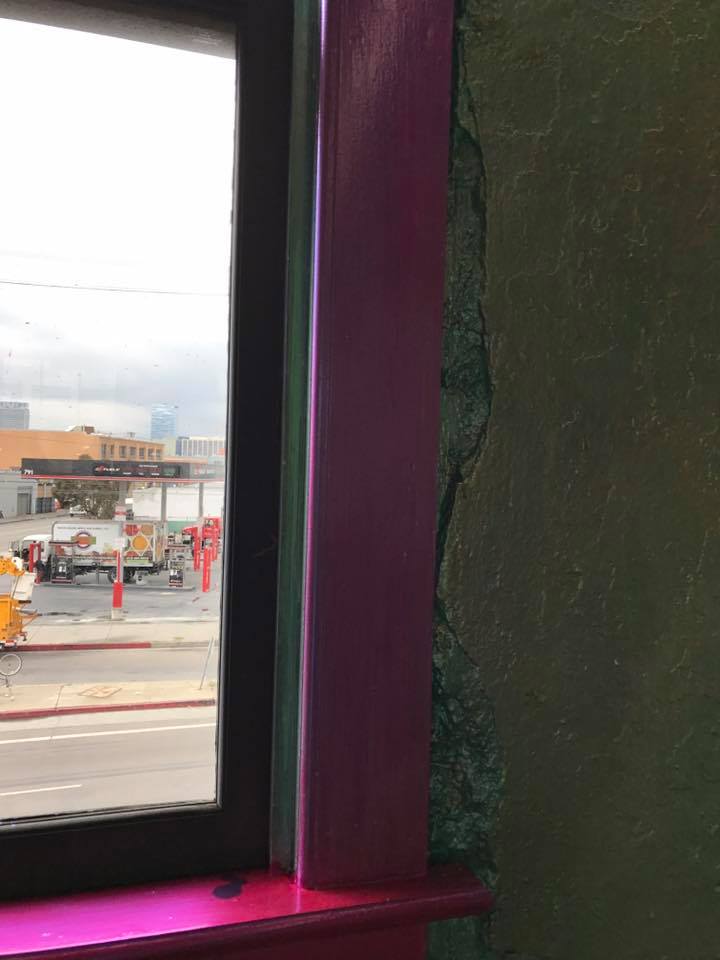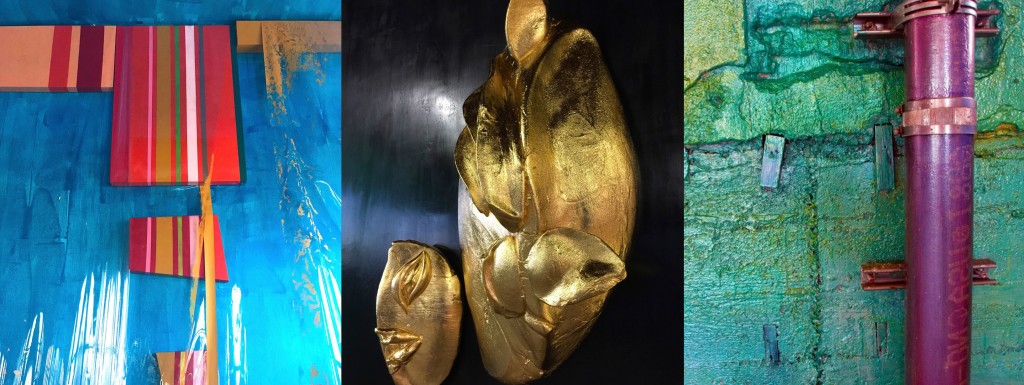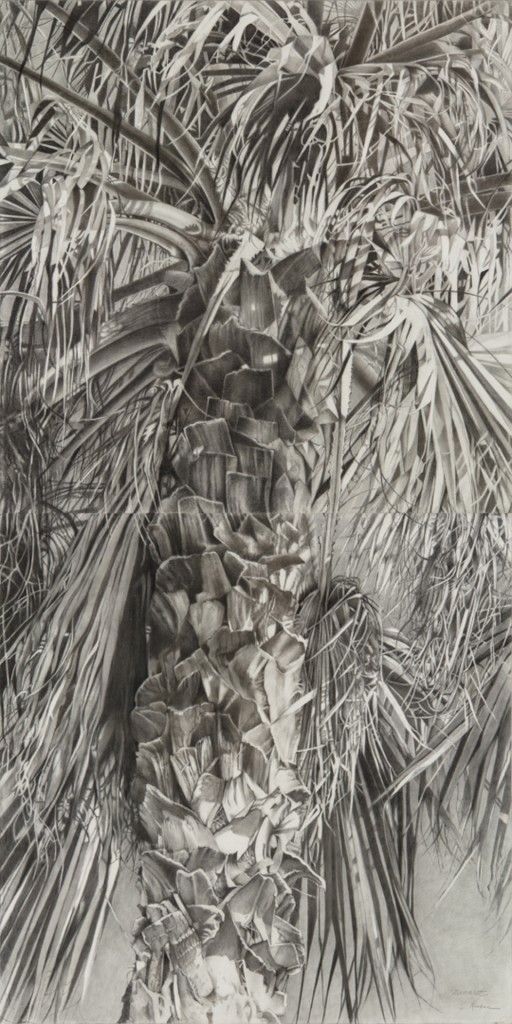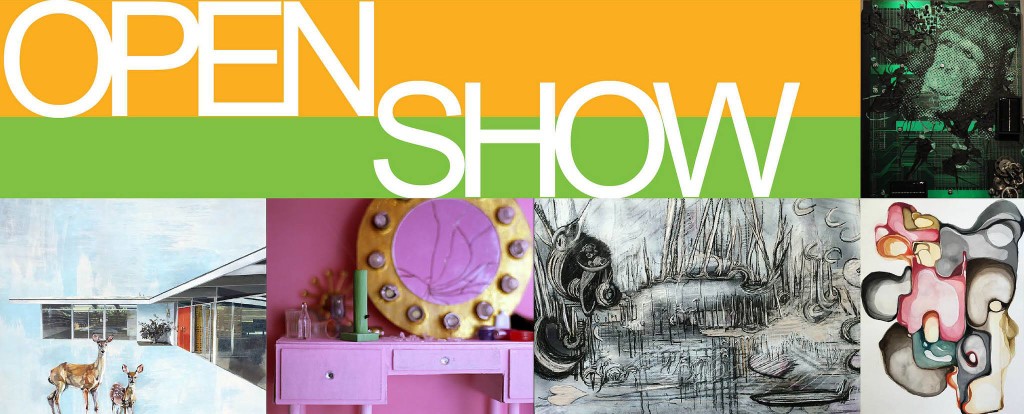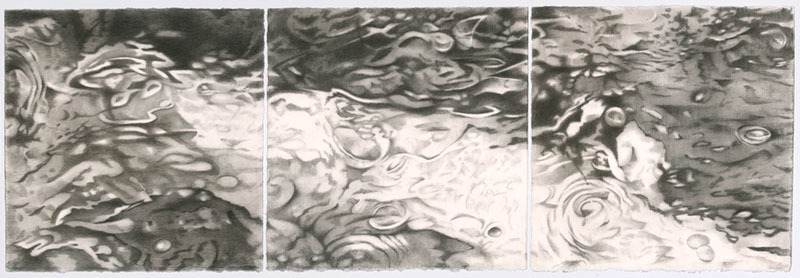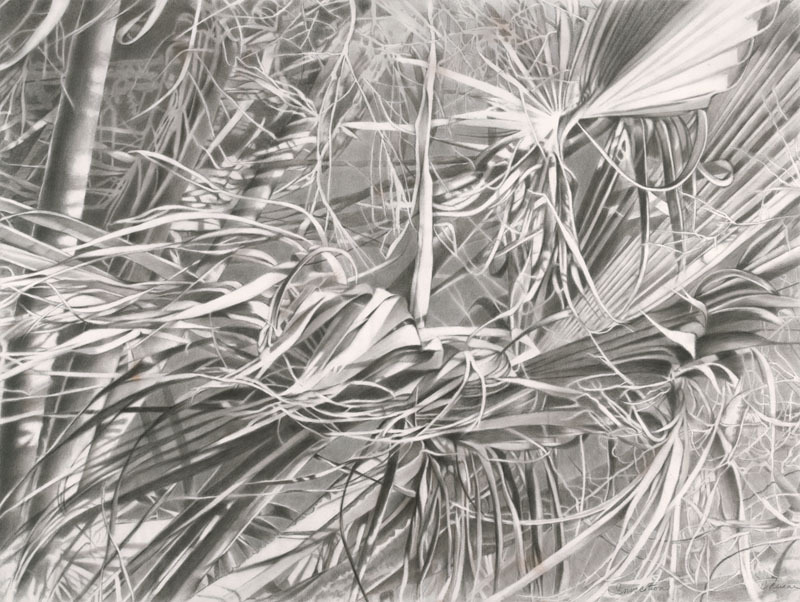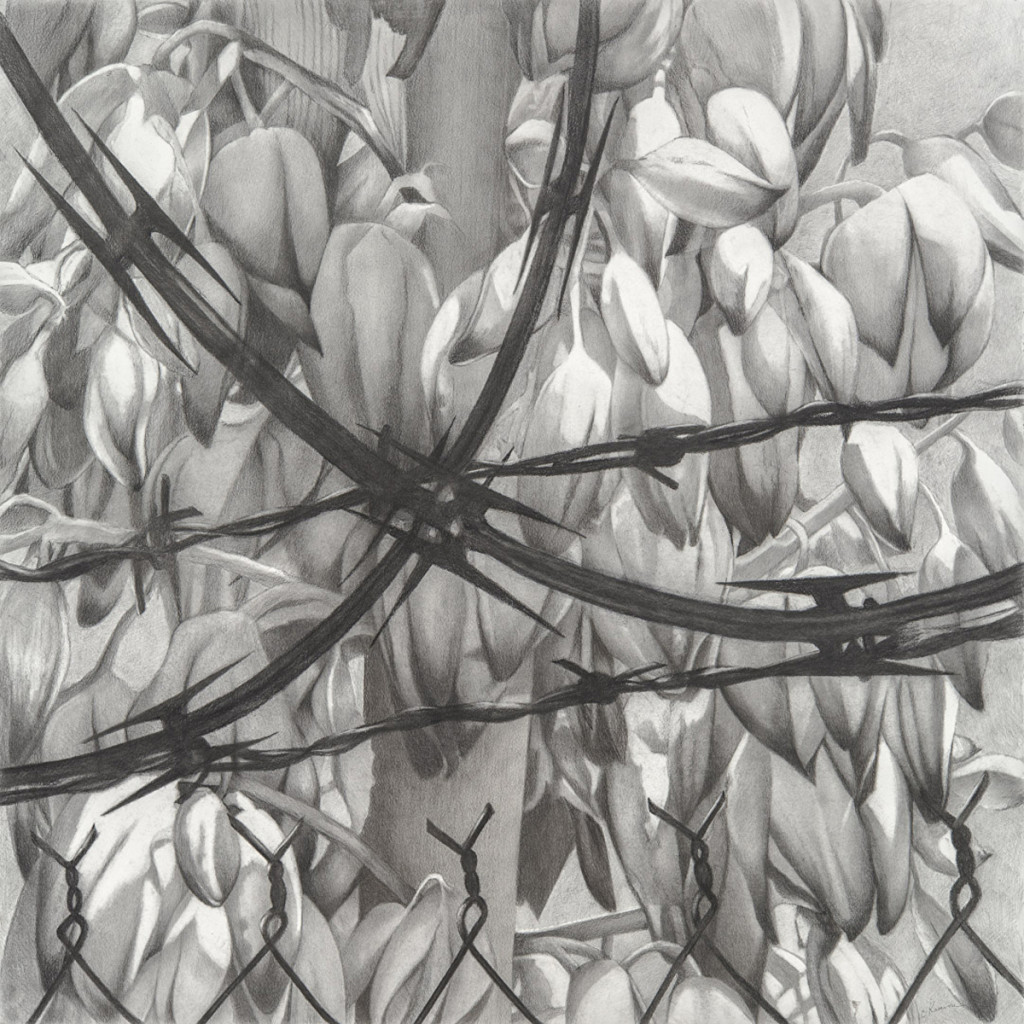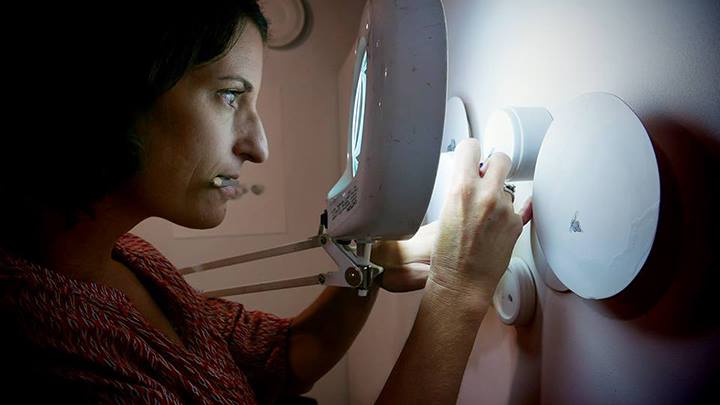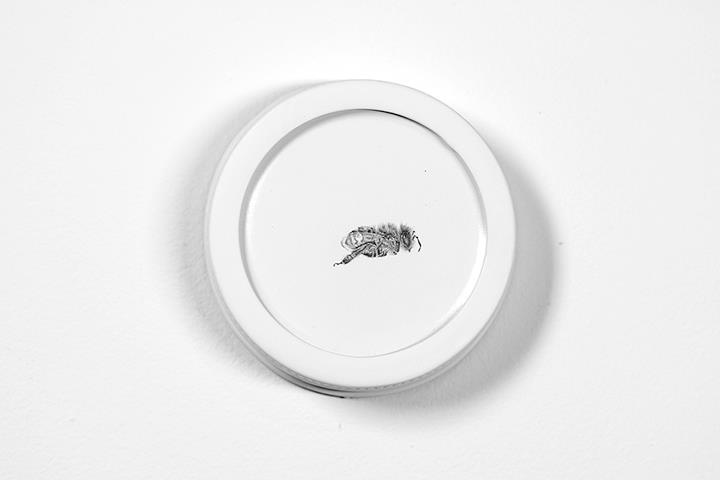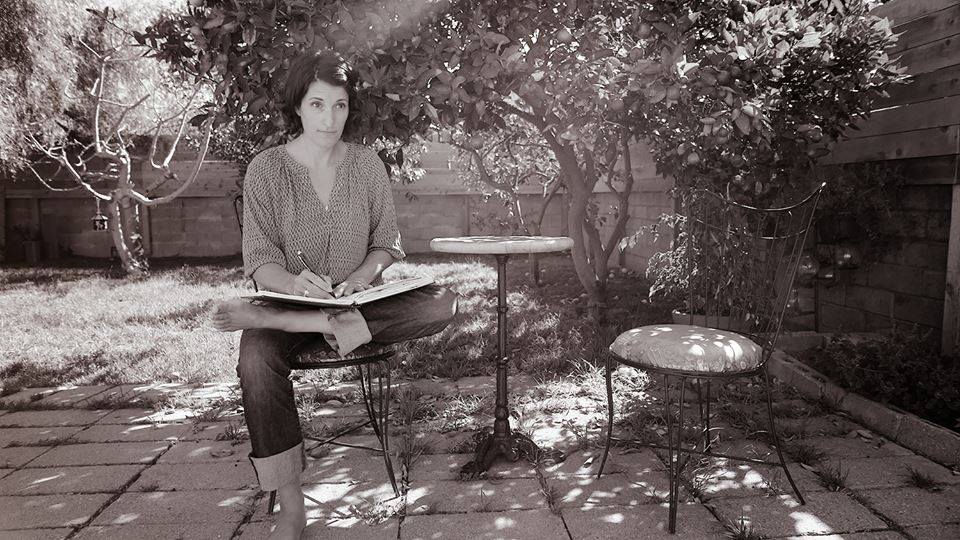A new and stunning project space is opening this Sunday January 8th with a reception from 3:30 to 6:00 p.m. at the 7th Street Produce Market. In this historic but unlikely setting, artists Zadik Zadikian, Kaloust Guedel, and KuBO present four immersive, large-scale artworks that dazzle with their conceptions of texture, light, color, and on-going evolution.
In a building constructed 100 years ago, Zadikian has established a studio project space that turns its environment into a work of art. His plan is to watch the artwork unfold and grow with new elements to be added to existing works and new artists to create their own visual compositions.
On Sunday, viewers will see four pieces: Zadikian’s “Foreigners,” his untitled gold-leaf wall, Guedel’s “The Coronation of Vagina,” and KuBO’s opalescent “Once Upon the Time in the West.”
Taken as a whole, viewers will enter a magical, surreal space, one rich in concept and visual texture, vibrant in color, and alive in its transitional, creative state. Individually, each piece is likely to burn a succinct, dazzling image into the viewers’ retinas, creating memorable visual moments that resonate with meaning. These are highly interpretive, experiential works; art that will have viewers discussing it, analyzing it, and simply reveling in its depths.
Zadikian found his project space four years ago, and began work on what he calls his “semi-permanent” installation shortly thereafter. Sunday’s reception marks his soft opening, with a larger opening planned for spring.
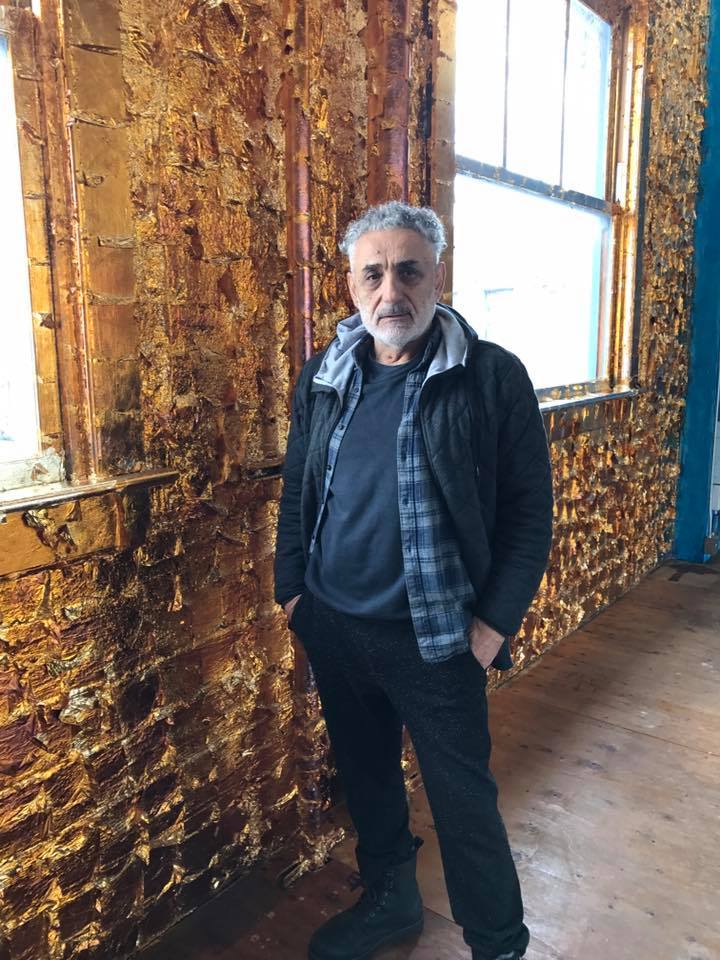
On the east wall overlooking the produce market, Zadikian has created a gold wall, one which glitters in the light, that moves with the delicacy of wings as air filters throughout the space.
“I used imitation gold leaf purposely, so that you become aware of time as the colors of the leaf changes,” Zadikian relates. When newly mounted, the delicate gold leaf is glittering and shiny. Where the elements reach the work, and age it, the leaf turns coppery, bronze. The most exposed areas, window frames drenched in light, coated industrial piping, are turning purple and blue.
“There are some overlaps of the leaf where the elements can’t get in and that will stay shimmering gold. The surface, top layer will gradually turn blue black,” the artist explains. “I used to cover entire spaces in New York with gold leaf, the whole concept is to petrify by casting in gold.”
This work feels very much alive, as much a meditation on the passage of time, of life, breath, and being, as it is a stunning art work that dances with light. It reflects on our intimate, intrinsic concern with aging, how we shift, change, the shininess of youth undone by the days and years in which we live. There is a haunting, poignant feel to the work that is almost evenly met by a sense of being uplifted, gratitude for the process of living which includes aging itself.
“It becomes very much alive, it flutters, it is the awareness of material and air, very peaceful and meditative,” Zadikian says. “It is a simple application of material, each piece 5″ by 5″ square.”
The result is like alchemy writ large across a 12-foot-high and 60-foot-long brick wall.
“I started the work when I moved in three and a half years ago, and I finished it this year. What happened over time was not intentionally done. I didn’t know you would get a natural patina, that nature would take over. The overlaps, the movements are intentional, to create awareness of the material,” he says. “But the discoloration was discovered. I had always worked only with genuine gold leaf before, and that never changes. It is timeless.”
The pieces plays with light, with motion, making viewers hyper aware of its fragility, and Zadikian’s assertion that the piece is “like butterflies on the wall.” Certainly, like a butterfly, the piece undergoes a metamorphosis, a transformation, and visual zeitgeist.
Directly in the center of the large project space is Zadikian’s free standing “Foreigners.” The artist refers to the real gold leaf gilded sculptures on their rich black background as subconscious sculptures.
The cast gold works, hung on the background with magnets, are mesmerizing. Study them to find faces, lips, noses, eyes, creatures.
“The title, ‘Foreigners’ refers to ideas coming from the subconscious, images of creatures coming from space. Every day I would come in to work and never know what I would come up with,” Zadkian smiles.
“I think the real creativity is not knowing what you’re going to come up with. You go to unknown places. We are all afraid of uncontrolled forces, but when you accept that power it is amazing.”
Zadikian’s stunning work is not finished yet. “I’m coming up with another five thousand tiny pieces to add to it. It will become a galaxy with no beginning, timeless, using materials and forms created by natural forces and gravity.”
That the piece is rich enough to evoke an entire universe is unarguable, the features on the sculptural works also feel representative of the spiritual dimension to human existence; souls, perhaps strange angels.
“You see everything because of the gold, it is not used here because it is a precious metal but because through it’s experience you can see the forms immediately.”
Zadikian shapes these forms by literally dropping the clay he works with against the studio floor. “I bang it on the floor and the mass of gravity and the clay together, those two forces create the shape, the form. I move the soft clay and bang and turn it until I get shapes that stop me intuitively. When I see the shape that makes sense, I stop and add a few details like eyes, nose, lips, to reference those features.”
At that point the artist makes a mold and casts it on plaster. The mold is broken with a chisel. Referring to the processes that preserved mummies and sarcophagi in ancient Egypt, Zadikian wraps the plaster with burlap to reinforce it while it drives. Then he applies several coats of shellac to seal the works “because plaster is porous.”
When the shellac layers dry, he applies gold-size that’s oil based. The gold leaf is then applied and sticks to the surface. “This is called oil gilding,” the artist explains.
His black backdrop is created with a mix of black color and plaster layered onto the surface. “It took three weeks just to get a certain texture and thickness, and then it is finished with six or seven layers of black shoe polish,” which creates the textural richness and vibrating depth of the blackness.

“Foreigners” is positioned directly across the project space from Guedel’s work, “The Coronation of Vagina.” Referring to his work as a fresco rather than an installation, Guedel, too works in layers. The piece covers the north entry wall, and consists of a paint and plaster bright blue background and another layer created with translucent vinyl with paint in sections. Between these, vinyl geometric shapes are hung or lie among the flowing clear vinyl sheets. Just as Zadikian’s gold wall shifts in the wind, Guedel’s work shifts in the light, creating the illusion of water flow, sun beams, and moonlight.
Guedel is a part of the so-termed excessivism movement, one which reflects and examines every aspect of life in an excessive state. It depicts the exessive use of resources in visual creations, with a goal of examining the capitalist system. Putting these prescient but political dimensions aside, Guedel’s work was a five month process, it’s title and intent to emulate the birth of a child entering this space of artistic vision.
Working in vinyl and acrylic, Guedel says “My starting point was the architectural structure I used to compose. The imposition of the door, the electrical outlets, the faucet on the space, accepting it as it is and working with that. When I was finished with the piece, I couldn’t see the explanation for the door, so I used it as the center.”
The shiny white door – the physical entrance to the space – stands aside, a blank spot that aches with and for meaning.
“I added the yellow vinyl pieces as a crown-type element and then the title came to life,” Guedel says.
The vibrant, almost royal-blue wall was initially painted with a roller, then painted over with white and begun again. “When I started again I added more water and used a spatula to apply the color. It’s an art to create the wall, and the wall is an important part of the art. Move the art anywhere else and it would be a different piece,” he asserts.
The geometric vinyl shapes are stretched over wood in the same way that canvas would be stretched. “The pieces have horizontal and vertical shapes. Those that are on the ground are in motion, they were pulled to the ground.” The piece has a flow that connects the top of the wall, and the rich blue which climbs the ceiling space as well, all the way to the ground. There is a huge, indomitable flow to the work which is, Guedel says, a continuation of previous works that were part of a six painting series. This work is 16 feet high by 47 feet wide. He has also experimented creating a smaller single color 12-foot piece that incorporated fiber optics. “The soft material brings into play organic formation in contrast with the geometric forms,” he says.
Physically larger than life, the viewer experiences the piece with a sense of the architectural space in which it is shaped, and its dimensionality pulls the viewer into its layers, as if the act of seeing the work added yet another layer.
On the west facing wall is the appropriately named “Once upon a time in the West” by KuBO. Again, texture is a strong element in this work, which uses the existing texture of the uneven wall and takes it to a new plane of visual existence.
Offering a dreamscape of sea foam, pearls, and opals, the iridescent, pearlescent space glows from within and without. Violet colored window sashes are a lush counterpoint to the shifting translucent greens.
The artist is known to capture luminescence in his work, which at times utilizes some of the attributes of large scale photographs, through its reflective use of light and color.
The artist was not present at the studio during our visit; German-born, KuBO splits his time between LA and Hong Kong, and is involved with the international Green Movement.
Zadikian is thrilled with KuBO’s work. “I had a vision of making a pearlescent space, walls that get rid of the cheap white gallery walls that have become a cliche, that there is something cold and trashy about, that can be painted over and over. This space has very special form to me, the space itself is a found object.”
Utilizing that found object, KuBO works here with polyurethane layered between pigments, creating spaces in which the light reflects the colors back. Depending on the angle at which a viewer stands, Zadikian notes, “you become aware of the light. It’s not an opaque, fixed color.”
There is a jewel like quality to this wall, it is not decorative material, it becomes something layered; it is a chameleon, a rainbow, flower petals, lizard skin, peacock feathers. Specialized aqua pigments bring out the layers in the existing wall, create shadows and shapes, but this is a piece that is all about color as image.
As to the entire project space and the works of all three artists, Zadikian says “I had gilded spaces in gold, I knew how to alter space. I want this space to be about giving birth, giving space to artists to create.”
Enter this new universe at The Project Studio, located at 1318 E 7th. Street, L.A, CA 90021. At Sunday’s opening, art critic Peter Frank will speak at 4:30 p.m.
- Genie Davis; photos by Ellen Riingen and Genie Davis, triptych image courtesy of artist


